Michigan vegetable crop report – July 10, 2024
Disease pressure is ramping up and more “diseasey” weather is ahead of us this week.
Weather
There will be a hiatus in our report’s weekly weather forecast for the time being. Please consult the National Weather Service website or the forecasts accessible through Michigan State University Enviroweather for your area.
Produce Food Safety On-Farm Readiness Reviews
On May 2, the U.S. Food and Drug Administration (FDA) released their final revisions to the Food Safety Modernization Act Produce Safety Rule Pre-Harvest Agricultural Water Rule. If you are a grower in Michigan, this is a great time to schedule an On-Farm Readiness Review (OFRR). Not only can our team help you assess your on-farm produce safety risks, we can help you assess your water system in light of the updated water rule. If you have already had an OFRR on your farm, no problem, we are happy to come back out to help you assess your water system based on the new parts of the water rule.
An On-Farm Readiness Review (OFRR) is an opportunity for a grower to walk around their farm with their local conservation district produce safety technician and a produce safety specialist from Michigan State University Extension. These 2-hour educational visits take place during the harvest season and are meant to be casual and low stress. Everything discussed during an OFRR is confidential and focused on ways a grower can reduce their own risks in relation to produce safety. There is no pressure to take our advice either, we are just here to support you in your produce safety efforts!
Boron
For some reason, boron (B) toxicities have been reported around the state this year. B is not a mobile nutrient in plants, and so it accumulates in the oldest tissues and generally stays there, or appears to move up the plant as new growth becomes old growth. Toxic amounts of B cause the edges of leaves to curl up like a draw-string bag and burn from the edges inward. These leaves can eventually fall off the plant, giving the appearance of naked stems on peppers.
In most cases, boron is sold in single-nutrient products ranging from 10 to 20% B in granular and liquid states. In liquid pre-mixes, it is rarely higher than a fraction of a percent. This is because it takes very little boron to achieve sufficiency and is easy to overapply. In crops that benefit from B additions, the rates are seldom more than 2 pounds actual B per acre. It is often easier to manage as a standalone product or in a custom mix that you’ve already done the math on. When toxicity occurs, the best thing to do is to flush it out with straight water. Attempts at overapplying another nutrient, like calcium, to “outcompete” B at binding sites can just create additional nutrient imbalances.
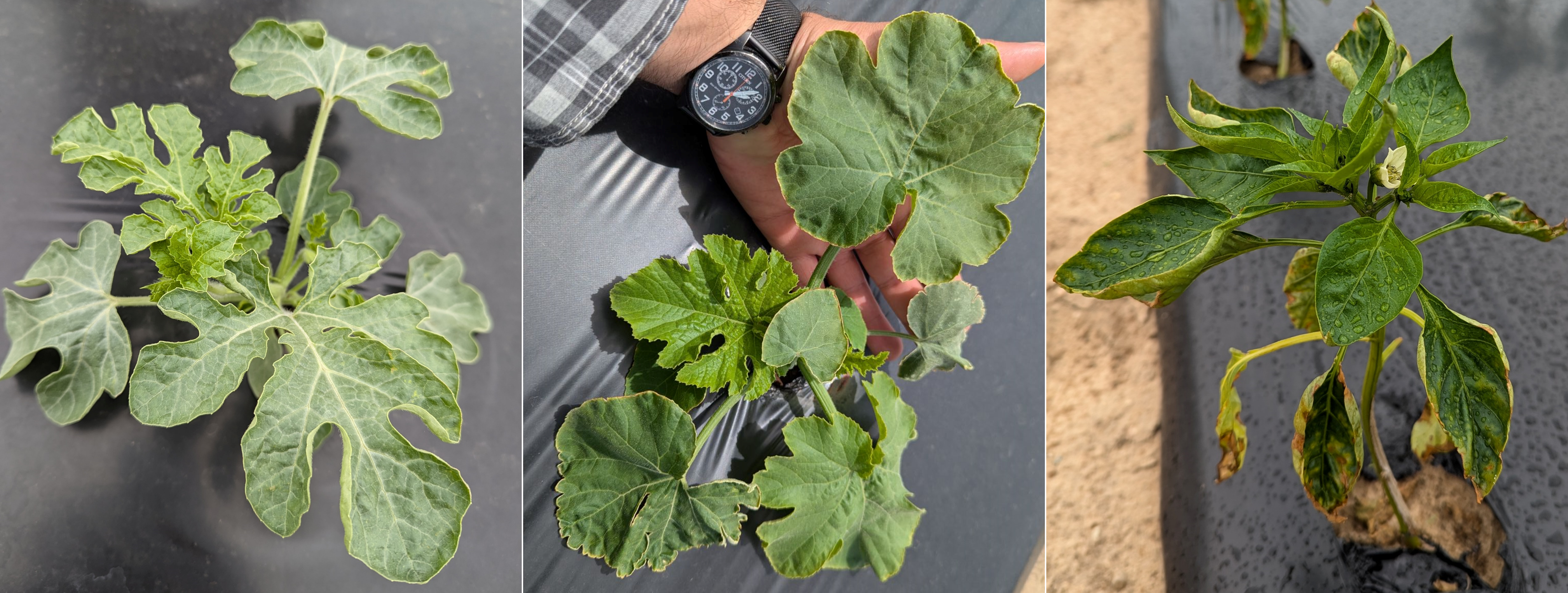
Crop updates
Asparagus
In west central Michigan, young fields are dark green while later harvested fields are flowering and ferning out. New shoots were developing with the recent rain.
High dew points, warm and rainy weather mean protecting fern from foliar disease will be important. Purple spot is driven by long periods of leaf wetness in combination with high temperatures. The TomCast disease model combines leaf wetness and temperature into Disease Severity Values (DSVs), creating a “spray by numbers” system. For purple spot, it is recommended to apply fungicides whenever 15 DSVs accumulate since the last application. Chlorothalonil, mancozeb and azoxystrobin provide protection against purple spot. Under especially favorable conditions as we’ve had this year, azoxystrobin should be used. Applying azoxystrobin in combination with either chlorothalonil or mancozeb could be a helpful strategy in high disease pressure situations.
Efforts to control purple spot are needed as purple spot lesions are present in some locations on the main stem and cladophylls. Also, keep an eye out for the development of Phytophthora crown and root rot in asparagus plantings, which may appear as a “shepherd's crook” appearance to the fern stalk. Unfortunately, there is not much that can be done once the Phytophthora disease develops in the field.
Japanese beetle and common asparagus beetle adults, eggs and larvae were present in some locations. The grower-standard carbaryl plus permethrin mix is effective, as is Assail (active ingregient acetamiprid).
Brassicas and greens
Broccoli, kohlrabi, some cabbage, kale and salad mixes of all types are flowing into markets, while fresh plants are still being planted. All caterpillars and beetles can be found, with thrips as well in some situations. High leafhopper pressure can bring infections from aster yellows. Infectivity rates of leafhoppers is high this year, meaning it takes fewer leafhoppers to transmit the disease. For information on aster leafhopper thresholds and aster yellow infectivity risk, check out this recent article from Zsofia Szendrei and consider signing up for the text alert system.
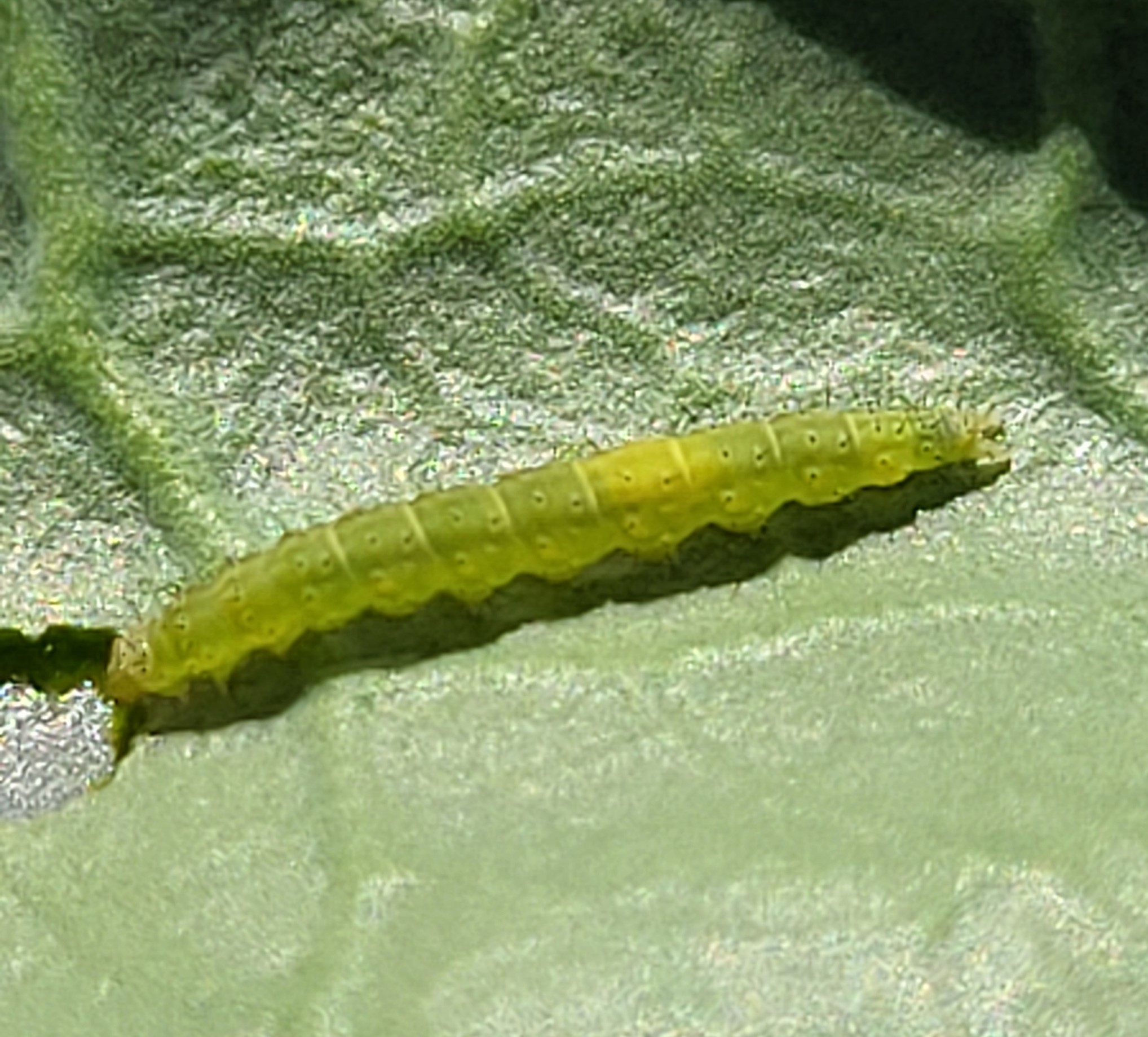
Clubroot disease has been detected in Brussels sprouts and cabbage. Clubroot is a disease that affects plants in the Brassica family. Clubroot is caused by the parasitic protist Plasmodiophora brassicae. The pathogen infects roots and causes them to swell which gives the roots the clubbed experience and hence gives its name. Above ground symptoms may include stunting, wilting and leaves turning yellow. Younger plants may be killed. Older plants may fail to produce a harvestable head. Secondary pathogens can infect clubroot diseased plants causing breakdown or turning black.
The pathogen forms thick-walled spores that can live in the soil for many years. Spores can be moved in the farm equipment and tools and by wind on soil particles for a short distance. For management options, please refer to Midwest Vegetable Guide. To learn more about this disease, check out this article from Cornell University.
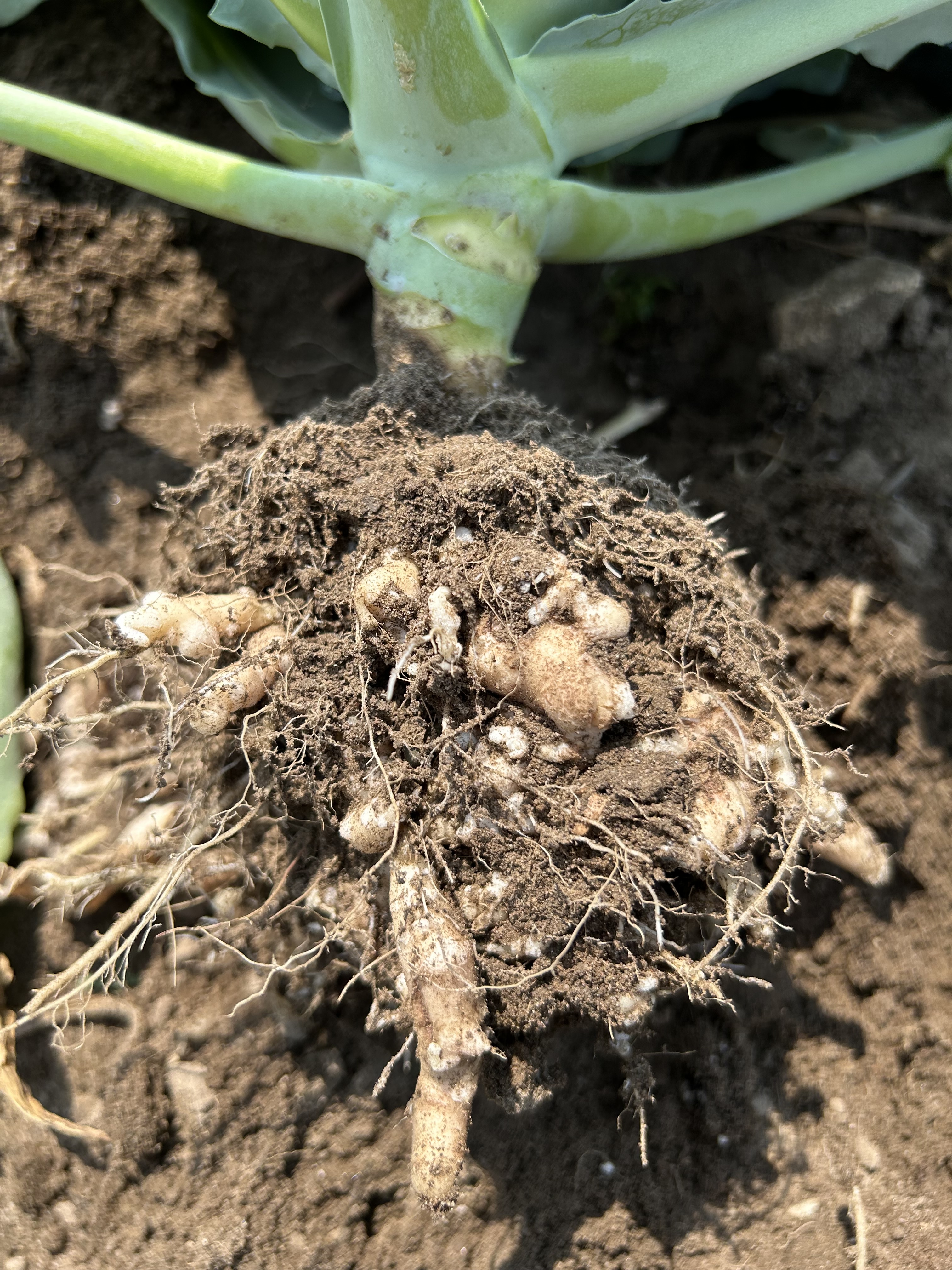
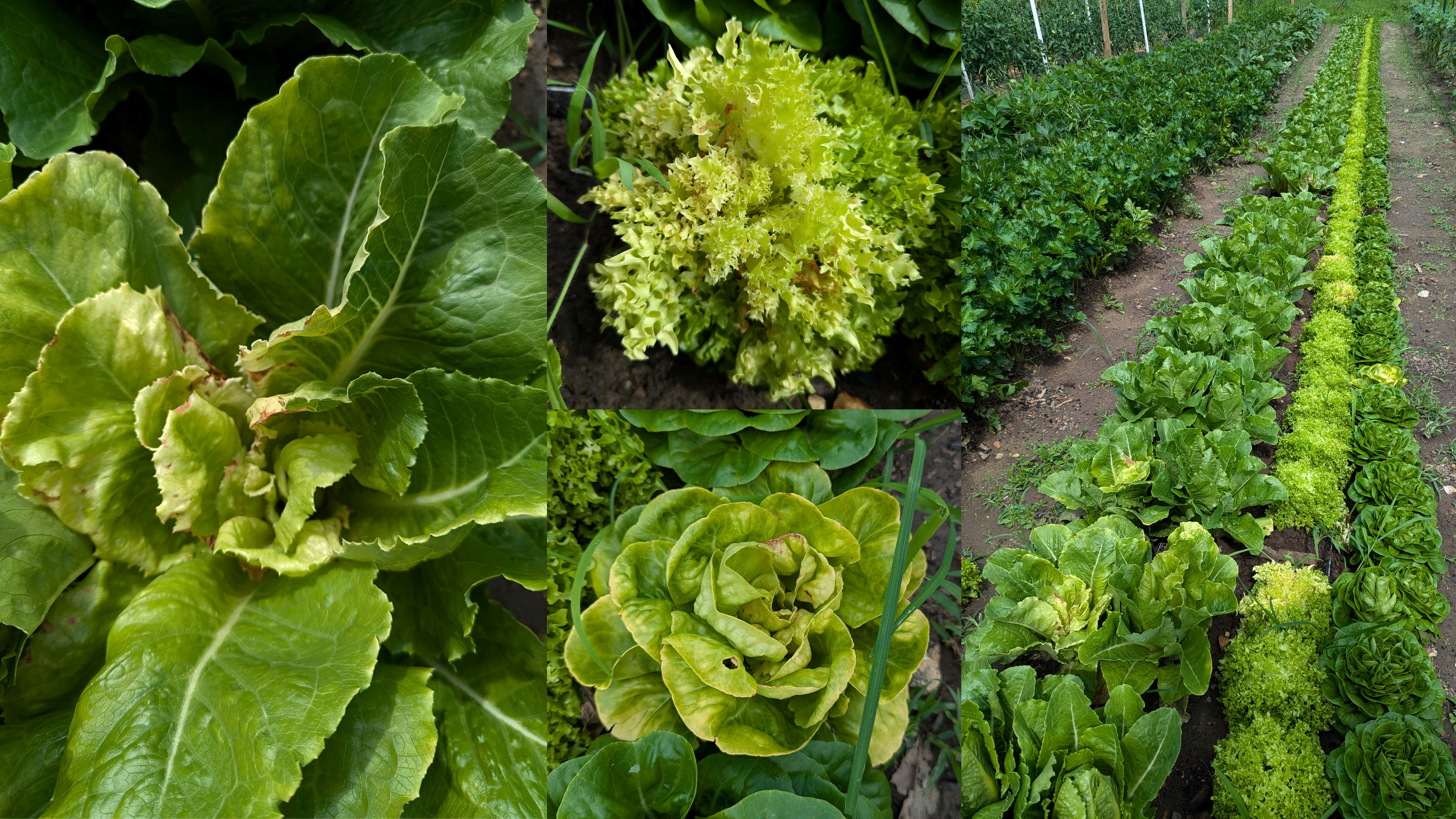
Carrots and celery
Foliar leaf blights of carrots caused by Cercospora or Alternaria may be expected to develop their first symptoms during this time and preventive applications are needed. Previous MSU research has shown that once blight is well established in a field, it becomes especially difficult to turn the situation around even with an aggressive fungicide program.
Symptoms of aster yellows have been visible in carrots and celery. In carrots, symptoms can include yellow or maroon foliage, hairy roots and distorted, “lacy” new growth. For information on aster leafhopper thresholds and aster yellow infectivity risk, check out this recent article from Zsofia Szendrei and consider signing up for the text alert system.
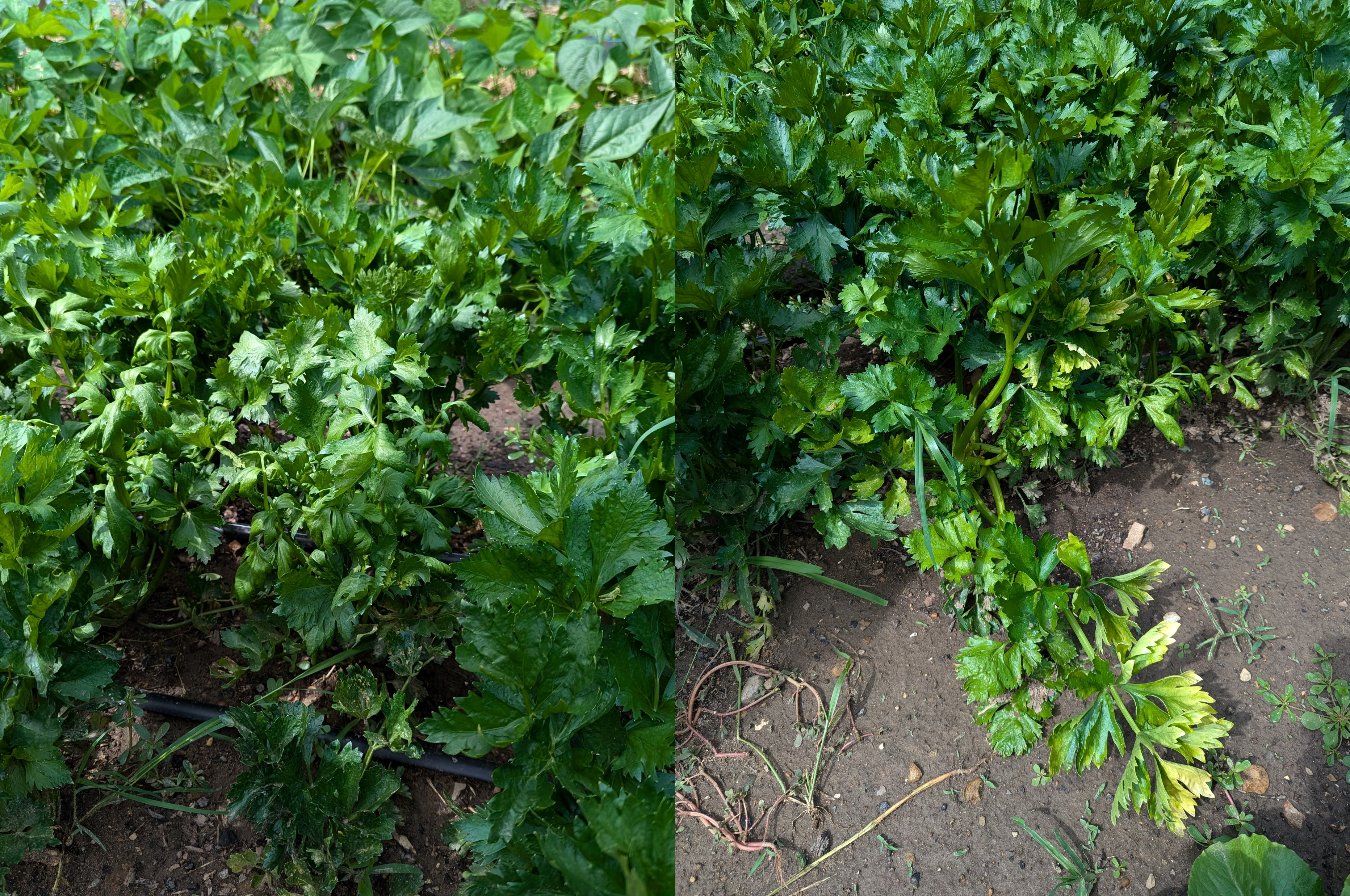
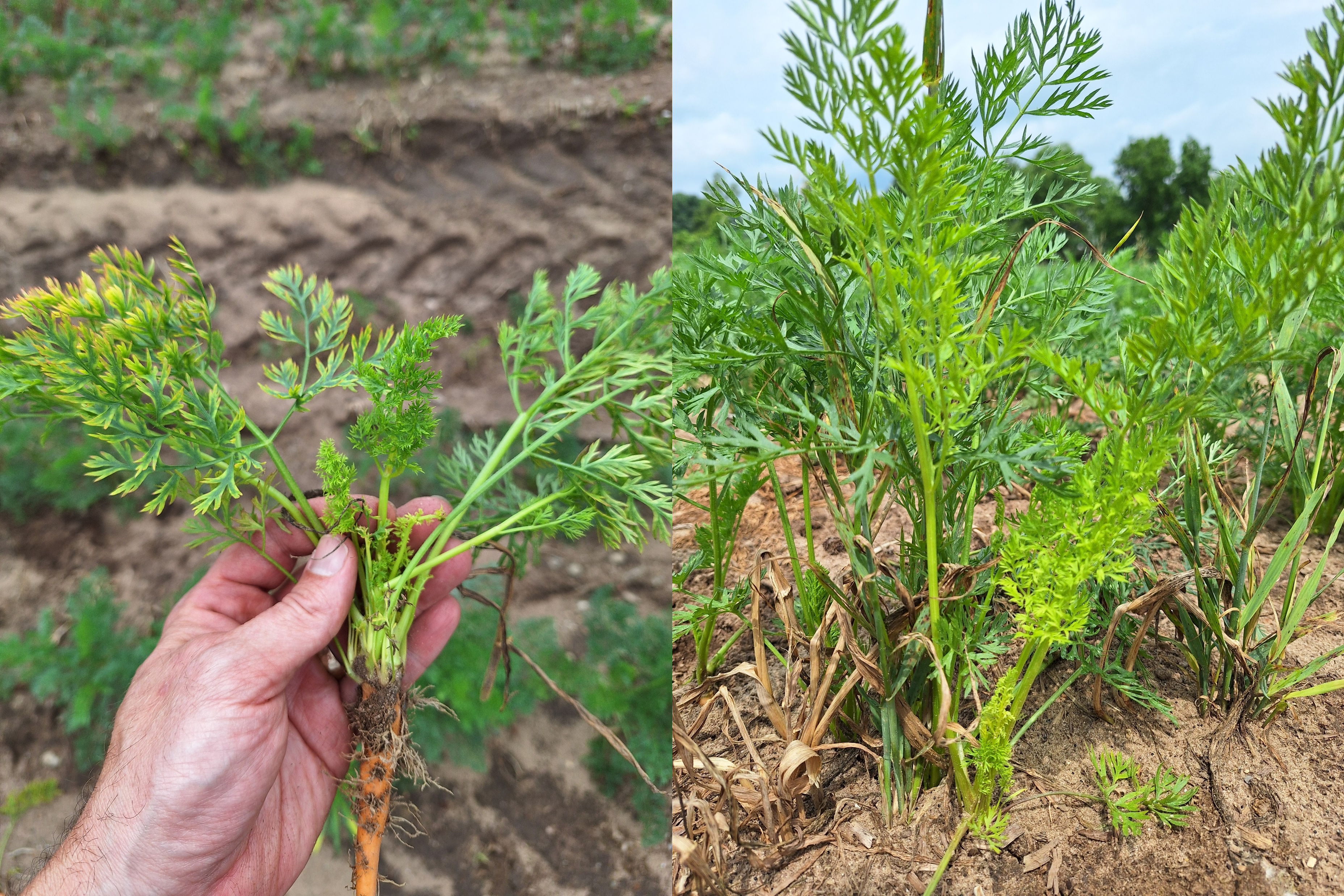
Cucurbits
Mechanical harvest of pickles has begun. Bacterial wilt and different viruses have been reported in cucurbits.
Cucurbit downy mildew was recently detected on cucumbers in Washtenaw County. The MSU Extension news story contains fungicide recommendations for 2024. Keep up to date on the development of this destructive cucurbit disease at the Hausbeck Downy Mildew News website. In addition to this confirmation of disease development in the field, we have had positive detection of cucurbit downy mildew spores in four counties across the state, indicating there is widespread exposure to the pathogen. The qPCR results indicate that the pathogen is Clade 2, which favors cucumber and melon. At this time, pumpkins and squash are not at high risk for infection.
Given the weather conditions of this growing season, all cucumber and melon growers should be using downy mildew specific fungicides as recommended based on yearly MSU fungicide studies (see links above). With the storms that some regions are experiencing, there is concern that the downy mildew pathogen will be favored in a way that hasn’t been seen in recent years. It may be prudent to shorten spray application intervals to protect vulnerable crops during wet and rainy periods.
Michigan producers are experiencing significant losses in squash and cucumber from Phytophthora capsici following some heavy rains in the state. With the recent heavy downpours that some regions have experienced, it is likely that disease symptoms will increase and cause additional plant death. The most obvious symptoms on the fruits are white spores that look similar to powdered sugar on the fruit surface. Eventually, the infected fruits will rot as secondary organisms invade include soft rot bacteria.
It is possible to harvest fruits that look healthy, but symptoms of Phytophthora appear days later while the crop is in transit or on grocers’ shelves. Symptoms on the roots and crowns include browning of tissue and rot, and lesions may appear on the foliage especially under wet conditions. The best way to avoid Phytophthora in a field is to take preventive measures before there is an outbreak. If there is a history of Phytophthora in a field, do not plant susceptible crops in the future.
If Phytophthora is recognized in the field, remove the diseased plants and the surrounding, healthy-looking border plants. Make sure to clean any equipment used in the field to prevent spread to other areas and discard the infected fruit in an area where crops are not grown. Hard squash and pumpkins can also be planted into raised beds, which allows for excess water to move away from the susceptible root and crown area.
For most crops, applying fungicides early and often is recommended. Many hard squash and pumpkin plants produce large, dense canopies and proper application equipment is often required to achieve adequate protection of the fruits. Air-assisted nozzles will push the fungicide through the canopy more effectively than conventional nozzles. Several fungicides are registered for use on cucumber, hard squash and pumpkin. In some Michigan growing regions, the Phytophthora is insensitive to the fungicide mefenoxam (Ridomil Gold, Ultra Flourish) and is no longer effective in these regions. If you do not have a history of Phytophthora in your fields, do everything you can to prevent it from occurring. Rotate fungicides to prevent the pathogen from becoming resistant.
Rapid decline and death of transplanted grafted watermelon seedlings was recently reported. Unfortunately, the timing probably was not the best and with the recent heat wave the seedlings did not survive well. Grafting is one of the new tools that growers in the U.S. are using now in tomatoes, watermelons, eggplant, squashes and sweet peppers. Grafted vegetable plants have greater vigor and more resistance to soil-borne diseases and nematodes. Learn more about vegetable grafting.

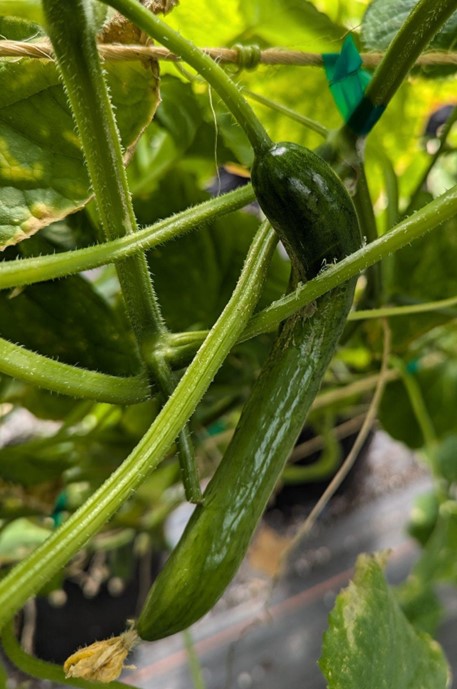
Fruiting vegetables
Harvests have picked up for most field plantings now that we are past that heat wave, and in many parts of the state there has been consistent moisture. Plants have been growing well but with the recent rains from Hurricane Beryl, we can expect diseases to thrive as well.
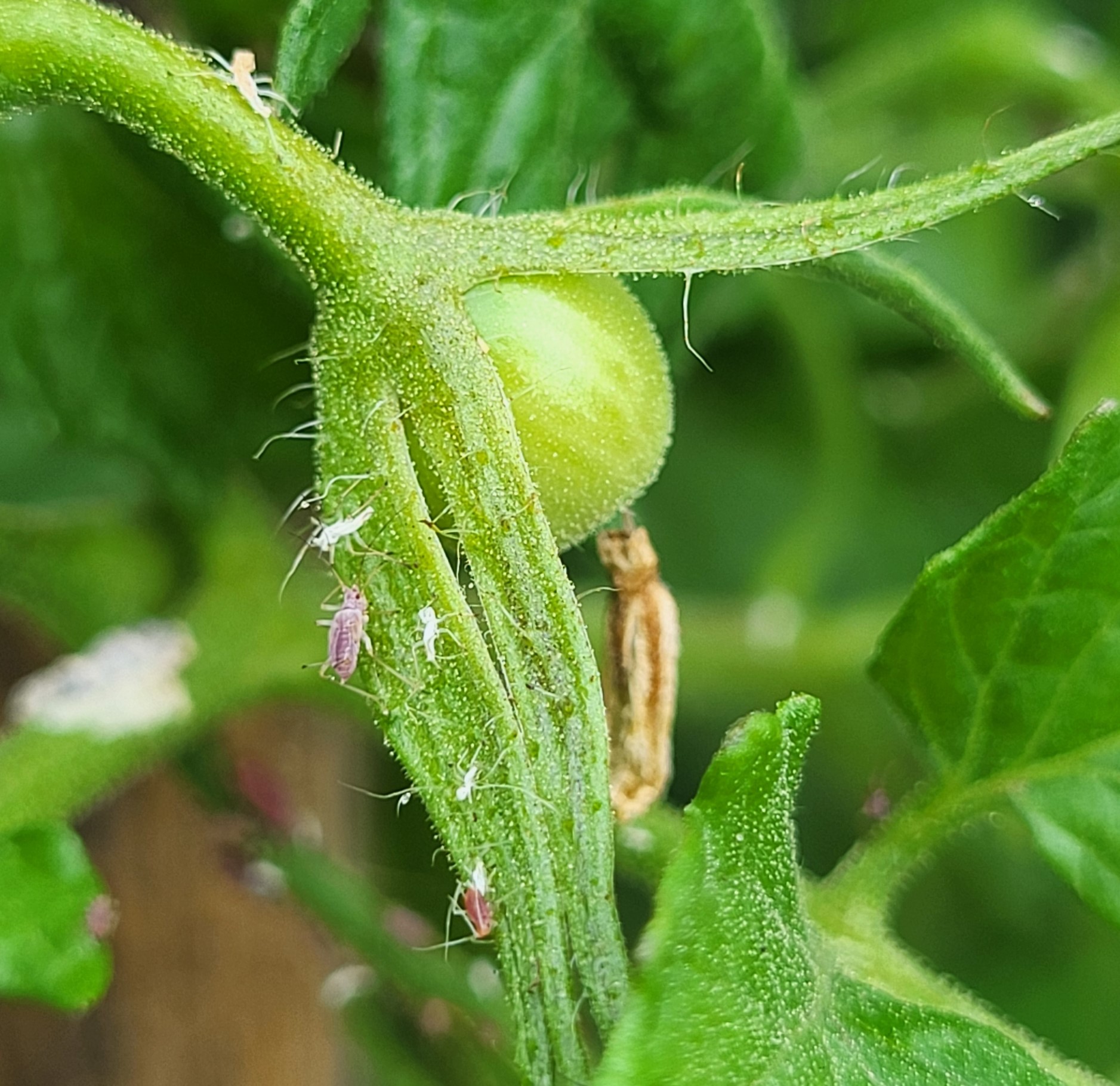
Late blight has developed on potato and tomato in Ontario, which could have important implications for Michigan tomato growers. This particular strain of late blight produces a lot of airborne spores that can be transported long distances. Also, this strain of late blight is known to be especially aggressive on both tomato and potato. Late blight is a disease that most commonly affects potatoes, but can affect tomatoes when the weather is cool, rainy and humid. In years with high rates of volunteer potato emergence, like this one, there is a potential for many unmanaged host plants.
The pathogen is called Phytophthora infestans and is well known to potato growers. Late blight symptoms include blighting on all aboveground parts of the tomato plant. Lesions on leaves often appear dark and oily with production of sporangia (seeds of the pathogen) occurring on the undersides of the leaves, resulting in a whitish/purplish appearance especially when conditions are wet and humid. These sporangia can be carried long distances from diseased plants to nearby healthy plants via wind currents and storm fronts. Blackened lesions on the stems also occur and are typical of late blight disease.
Late blight affects green and ripe tomato fruit. The blighting on the fruit appears as dark, greasy areas that enlarge rapidly encompassing the entire fruit. During wet and humid conditions, white masses (sporangia and threads) of the late blight pathogen can be seen on the diseased leaves and fruit. Between cropping seasons, the fungus survives on volunteer and abandoned potatoes in cull piles. Control measures include eliminating all potato/tomato cull piles and destroying volunteer potato plants that grow from overwintered tubers. Infected potato plants established from diseased seed potatoes are another source of late blight. Most tomato varieties are susceptible to late blight. ‘Mountain Magic’ is a late blight resistant variety.

There are several highly effective fungicide sprays that can be used to protect tomato plants from late blight. Homeowners and organic growers have limited tools available and may not be able to hold the disease once it starts. Conventional growers who use fungicides as part of their overall disease program for early blight, Septoria and anthracnose will provide some protection against late blight, especially early in the season. If late blight disease pressure increases, adding late blight specific fungicides to the spray program will be needed.
Onions and garlic
Onions and garlic may be about two weeks ahead of normal in some locations this year. This means onions may tip over a bit earlier than normal. Not a bad thing!
West Michigan scouts and growers noted an increase in possible Stemphylium symptoms over the past week. This coincided with a period of frequent rainfall, a “little rain every day” that kept foliage wet. In some locations, growers are about halfway through the spray season. As noted by MSU research, it’s important that fungicide sprays be started early and include the locally systemic fungicides noted below. This year’s weather has been favorable for foliar pathogens and a shortened application interval will likely be needed to control the highly aggressive Stemphylium pathogen.
Some questions have arisen about different premixes as many of these products include a FRAC 7 fungicide. Products that are a premix of two different active ingredients represent two different FRAC groups. Some examples include Luna Flex (FRAC 7/3), Luna Tranquility (7/9), Aprovia Top (FRAC 7/3), Miravis Prime (7/12) and Inspire Super (FRAC 3/9). Fungicides that are in FRAC group 7 include some of our most effective single-site, locally systemic products. When applying a premix that includes two FRAC groups, it can become complicated to rotate among products representing different FRAC groups. Fluazinam (FRAC 29) that is tank-mixed with chlorothalonil could be an option that can be used in rotation with other fungicides.
Root crops and potatoes
Late blight has been detected on potatoes and tomatoes in southwest Ontario. See the tomato section above for more information.
Cercospora has been reported on table beets. This is a common foliar pathogen of beets that shows up as pale necrotic spots with a reddish colored margin. The loss of tissue in the necrotic areas can leave a shot-hole type appearance that may resemble insect feeding. Cercospora can greatly reduce the quality of beets sold with their leafy tops. Using fungicides in a timely manner can prevent this leaf spot.
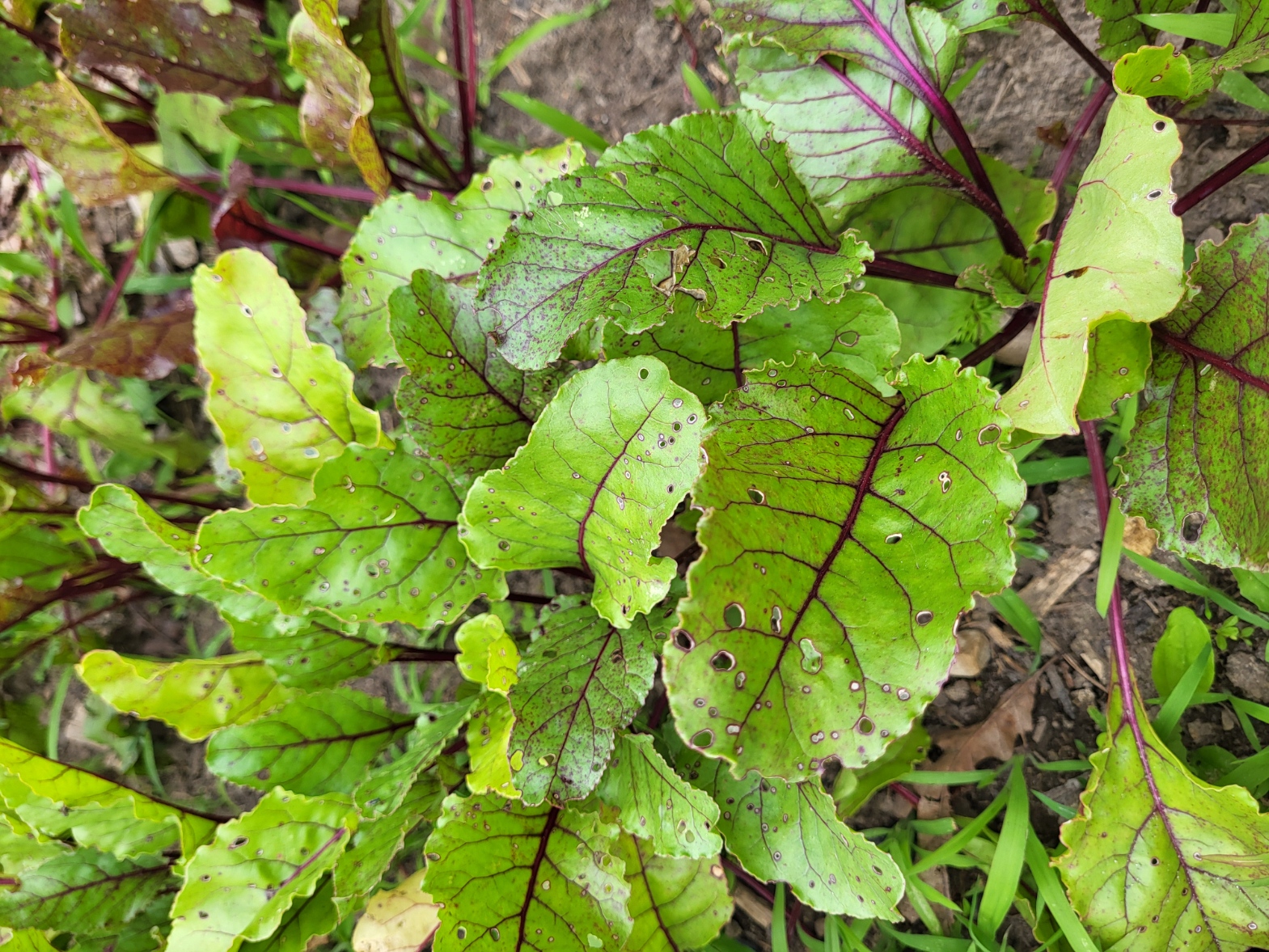
The summer generation of Colorado potato beetle adults is currently emerging from the ground in many areas of Michigan. The emergence of the summer generation adults marks the time when insecticide programs should switch classes of active ingredients. The table below lists foliar insecticides recommended for the summer generation, especially if neonicotinoids were used at planting. For resistance management purposes using the same active ingredient (IRAC) is recommended for the entire summer generation.
Scouting for Colorado potato beetle is an important part of correctly timing foliar insecticide applications and thus preventing insecticide resistance from becoming a major problem. Scouts visually survey multiple whole plants per field to count egg masses, small and large larvae, and adults. They record these numbers to determine if an economic threshold has been reached. The typical threshold used is one large larva per plant or one adult per plant on average.
|
Insecticide options for summer Colorado potato beetle management |
|||
|---|---|---|---|
|
Delivery |
Product |
Active Ingredient |
IRAC |
|
Foliar |
Agri-Mek, generics |
abamectin |
6 |
|
Foliar |
Coragen, Voliam Xpress1 |
chlorantraniliprole |
28 |
|
Foliar |
Exirel |
cyantraniliprole |
28 |
|
Foliar |
Admire Pro, generics |
imidacloprid |
4A |
|
Foliar |
Avaunt2 |
indoxacarb |
22A |
|
Foliar |
Torac |
tolfenpyrad |
21A |
|
Foliar |
Radiant |
spinetoram |
5 |
|
Foliar |
Blackhawk, Entrust |
spinosad |
5 |
|
Foliar |
Actara, Endigo ZC1 |
thiamethoxam |
4A |
|
1 premixed with pyrethroid, apply when potato leafhoppers are also problematic 2 Avaunt has limited activity on larvae |
|||
Sweet corn
The “Holy Grail” of sweet corn—a feast by the 4th—has been achieved by many this year with the warm spring. Some growers are moving past early varieties into more main season standard ones. Tar spot has been detected in field corn. Refer to the corn IPM map for tar spot to track the spread of the disease this season.
The corn earworm management season has begun as plantings produce green silks attractive to egglaying females. Earworm can be managed with pyrethroid, diamide and spinosyn insecticides. Pyrethroids are effective when moth pressure is not high, and include Hero, Ambush/Pounce, Asana, Baythroid, Brigade, Mustang Maxx and Warrior. Products with the diamide chlorantraniliprole (Besiege, Vantacor, Coragen) or the spinosyn spinetoram (Radiant, Intrepid Edge) are effective options for periods with high pressure. Spraying can be discontinued once corn has 90% brown silks, as it’s the green silks that attract egglaying females.
Overall corn earworm is present in many parts of the Midwest but as of today extremely high numbers have not been reported. Corn earworm has been present in pheromone traps MSU Extension is checking, and some west central scouts have captured moths as well, with some higher numbers in select locations (pointing to the value of having your own trap). Some growers have also reported earworm damage in early harvests. To our south, nightly earworm captures were mostly in the single digits for the past week in Purdue’s trapping network and present but low in Ohio State’s trapping network. The insect forecast website suggests a low risk of additional migration overnight with Hurricane Beryl.
|
Corn earworm captures. Total in trap for week1 (avg # per night2). |
||||
|---|---|---|---|---|
|
Week |
Monroe County |
Washtenaw County |
Oceana County |
Ottawa County |
|
7/8 |
- |
- |
8 (1.1) |
14 (2.0) |
|
6/30 |
0 (0) |
2 (.2) |
5 (1.0) |
30 (6.0) |
|
6/23 |
- |
- |
2 (1.0) |
|
|
1Total number collected since last trap check; 2The total number divided by the number of nights since the last trap check. |
||||
Western bean cutworm moths are flying at locations MSU Extension is monitoring, and increased numbers have been seen to our south in Ohio. Read the recent Ohio State report for information on scouting for this pest.
|
Western bean cutworm captures. Total in trap for week1 (avg # per night2). |
|||||
|---|---|---|---|---|---|
|
Week |
Monroe County |
Washtenaw County |
Oceana County |
Ottawa County |
Saginaw County |
|
7/8 |
|
|
3 (0.4) |
127 (18.1) |
26 (3.7) |
|
6/30 |
5 (0.7) |
29 (3.6) |
0 (0.0) |
11 ( 2.2) |
5 (0.7) |
|
6/23 |
|
|
0 (0.0) |
|
5 (0.7) |
|
1Total number collected since last trap check; 2The total number divided by the number of nights since the last trap check. |
|||||
Events
- July 11, 7-8 a.m., Field Crops Virtual Breakfast Series: Wild Weather for Hay
- July 18, 7-8 a.m., Field Crops Virtual Breakfast Series: White Mold - Tar Spot Spraying – Will it Pay?
- July 23, 6-8 p.m., Veggie Vibes at SWMREC
- July 25, 7-8 a.m., Field Crops Virtual Breakfast Series: Hot Topics Q&A Session
- Aug. 1, 7-8 a.m., Field Crops Virtual Breakfast Series: Cover Crops After Wheat
- Aug. 2, 10 a.m.-2 p.m., Organic Inspection Field Day at The North Farm
- Aug. 8, 7-8 a.m., Field Crops Virtual Breakfast Series: MSU Diagnostic Lab Topics
- Aug. 8, Potato Field Day at the Montcalm Research Center, Lakeview, MI
- Aug. 12, Small Farms Conference, Benzonia, MI
- Aug. 13, Farming for the Future Field Day at the West Central Michigan Research and Extension Center, Hart, MI.
- Aug. 15, 7-8 a.m., Field Crops Virtual Breakfast Series: Field Crops Nematode Update
- Aug. 20, 6-8 p.m., Veggie Vibes at SWMREC
- Aug. 20, Bean and Beet Day at the Saginaw Valley Research and Extension Center, Frankenmuth, MI
- Aug. 22, 7-8 a.m., Field Crops Virtual Breakfast Series: Lime Recommendations for Field Crops
- Aug. 22, Summer Bus Tour and Annual Field Day at the Northwest Michigan Horticulture Research Center, Traverse City, MI
- Aug. 29, 7-8 a.m., Field Crops Virtual Breakfast Series: Maximizing Wheat Yield Potential
- Sept. 5, 7-8 a.m., Field Crops Virtual Breakfast Series: Drought-Proofing Agriculture with Drainage Water Recycling
- Sept. 5, Long-Term Agroecosystems Research Field Day at the W. K. Kellogg Biological Station.
- Sept. 12, 7-8 a.m., Field Crops Virtual Breakfast Series: Grain Marketing
- Sept. 17, 6-8 p.m., Veggie Vibes at SWMREC
- Sept. 19, 7-8 a.m., Field Crops Virtual Breakfast Series: Late Season Weed Control
- Sept. 23, Field Day at the Trevor Nichols Research Center, Fennville, MI
This work is supported by the Crop Protection and Pest Management Program [grant no. 2021-70006-35450] from the USDA National Institute of Food and Agriculture. Any opinions, findings, conclusions, or recommendations expressed in this publication are those of the author(s) and do not necessarily reflect the view of the U.S. Department of Agriculture.



 Print
Print Email
Email




